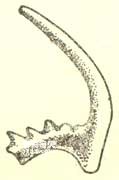Across the world, scientists have discovered a large number of tiny fossils from various marine strata from the Cambrian to the Triassic. Their shapes are very similar to various teeth, but they cannot be compared with any known animals. The teeth are so connected that scientists are still unable to determine the taxonomic affiliation of this type of animal. Scientists had to group them together and named them "conodonts" and believed that they were some kind of organ of an extinct marine animal.
The shapes of conodonts vary widely, including single cone shape, tooth bar shape, tooth flake shape, platform shape, etc. Scientists accordingly divided them into three categories: single cone type, compound type (including rod-shaped conodonts and tooth-shaped conodonts) and platform type.
The chemical composition of conodont is mainly calcium phosphate, which is generally insoluble in weak acids. Conodonts excavated from the formation are often amber brown, but as the temperature increases, their color changes from amber brown to black to light gray, transparent or opaque, and the texture becomes very brittle after deterioration.
Conodonts are abundant in formations that coexist with fossil cephalopods and fish fragments, as well as in formations containing small brachiopods, bivalves, gastropods, trilobites, crinoid stems, and graptolites. The content is less in limestone containing stromatoporoids, reef corals, brachiopods and ostracods.

conodont
We created this article in conjunction with AI technology, then made sure it was fact-checked and edited by a Animals Top editor.